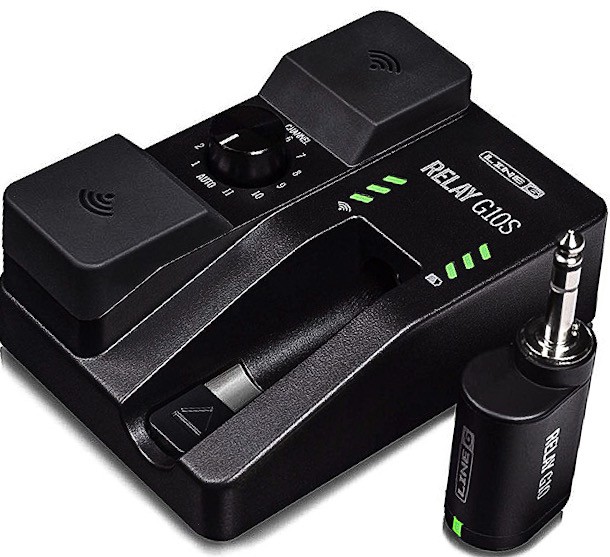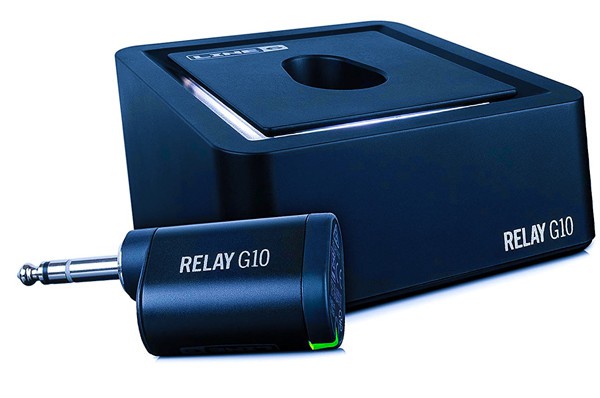Back in 2016, when I used the Line 6 G10, I absolutely loved it. It was the most convenient and easy-to-use wireless guitar system at I have ever used at the time. It did have its moments of quick cutouts. However, I was able to live with it for the time being. But the low price and convenience made the line 6 G10 an excellent buy for entry-level wireless systems. The only other problems I had in the year I used the G10 was (1) the all-plastic receivers USB port broke where I had to purchase a whole new receiver. (2) The transmitters died from sweat damage on three separate occasions where I had to replace them (only applicable to extreme sweaters).
Although I’m a happy user of the Shure GLXD 16 since late 2017, coming in the mail this week is the brand new Line 6 G10S for me to test out. The reviews on this article will be written as I study and use the G10S for the first time.
What’s my take on the line 6 G10s? The Line 6 G10S is the perfect entry-level wireless guitar system for small to medium-sized venues. It is the most convenient and easy to set up wireless instrument system to date while maintaining longevity and durability with its all-metal receiver.
Line 6 G10 vs Line 6 G10s

Benefits of line 6 G10S
- Range of 130 feet (80 more feet than the G10)
- Has a DC 9 Volt charging port which makes it easier to be charged on a pedalboard power supply. (G10 only uses USB charging port)
- The receiver is made of metal for durability and longevity. G10 is plastic)
- The option to automatically or manually select channel frequency. (G10 only has auto-select)
- The stomp-box receiver is specifically designed to fit snugly on your pedalboard. Rather than mounting your receiver on your amp before every show, having your receiver attached to the pedalboard decreases a setup step.
- Cable tone simulation option of 10 foot, 30 foot, or bypass.
Benefits of line 6 G10
- As expected, the only benefit the Line 6 G10 has compared to the G10 is that it’s $80 cheaper.
What’s new in the Line 6 G10S?
The cable tone simulator feature in the Line 6 G10S located in the back of the receiver. It gives you the option to simulate a 10ft or 30ft cable with the option to have it off. This feature gives you more options with your tone, whether you only use it for individual songs or entirely.
Unlike the Line 6 G10, the G10S has an all-metal receiver. Durability and longevity are 1 of the five most important factors that make or break a wireless guitar system. This could’ve saved me a few hundred dollars. Considering my old Line 6 G10 had to be replaced due to the plastic USB port on the receiver broke. This receivers metal build will have no problems of vigorous touring conditions for years to come.
Another great feature of the G10S is it’s designed to fit perfectly in your pedalboard. The old line 6 G10 was a tabletop receiver where most would have to set it up on the amplifier before every show while charging it with a USB port. The Line 6 G10S is a pedal receiver meaning it was designed to fit perfectly in your pedalboard with a DC 9 volt power supply. This alone makes the Line 6 G10S an even more accessible and more convenient wireless guitar system than the G10. As a matter of fact, there is literally no setup time with this system at all.
The most profound difference with the Line 6 G10S is its staggering range of 130ft when the G10 only had 50ft of range. Now we can take our guitar or bass solo while crowd surfing 50 yards out (;
The G10S gives you the option to either automatically or manually select the frequency channel. The G10 did not give you the option to manually select a channel, making you feel hopeless when receiving signal interference. In the case where you are performing in a diluted frequency band area where you run into interference, the G10S gives you the option to select the clearest channel for your area manually.
Similarities of Line 6 G10 and Line 6 G10s
- Both use the same G10T Transmitter (made of plastic)
- Both use 24-bit uncompressed digital transmission
- Both give off the same tone and audio clarity for your instrument unless you use the cable tone simulation on the G10S
- Neither is preferred to be used with active pickups (especially the active electronics that are wired with inverse polarity)
- Both transmitters are charged the same way by plugging it into the receiver
- Both have up to 8 hours of playtime per full charge
- Both operate at 2.4 GHz Both have the “No Pop” audio mute feature where the transmitter does not turn on unless completely plugged into the instrument
- Both transmitters flash red when you have less than 30 minutes of playtime
- Neither are negatively affected by phantom power
Line 6 G10 and Line 6 G10S Overview
Line 6 G10 and G10S operates at 2.4 GHz, which is the globally unlicensed, globally unrestricted, and more future proof frequency band. They use an auto encoded Digital Channel Lock which helps lower the risk of frequency interference.
Convenience
As a longtime owner of the Line 6 G10 and a current owner of the G10S, I can easily say there are no other wireless systems as convenient and easy to use. The G10S is slightly more convenient considering its pedalboard accessibility and DC 9V power. The transmitter for both systems has no buttons or cables attached, making it an easy plug-in and play.
Easily able to switch out instruments
Both of these units make switching instruments very easy considering the “No-pop” audio mute feature that eliminates unpleasant pops when plugging in or unplugging the transmitter. The transmitter only turns on when the instrument is fully plugged in.
How to charge it
The G10T transmitter used for both systems has a built-in rechargeable Li-ion battery that is charged by docking it into the receiver. The elimination of consistently purchasing costly disposable batteries in it of itself not only saves you money but time and hassle as well. The line 6 G10 receiver is charged by USB where the Line 6 G10S can be charged by USB or 9V DC power supply.
What instruments are they compatible with?
Both the Line 6 G10 and G10S are compatible with just about any stringed instrument unless the instrument has active electronics with inverse polarity. After 4 minutes of the transmitter is not in use, it automatically goes into sleep mode. The receiver for both units shows the transmitter’s battery via LED.
How long does it take to charge?
Back when I used the Line 6 G10 during my 4-hour gigs, I loved the fact I could recharge the transmitter at the break by just unplugging it from my bass to plugging it into the receiver. 15 minutes of charge gives it 1 hour of playtime, but a full charge takes roughly 3-4 hours, giving you 8 hours of playtime. I used to charge it before my shows backstage.
Sound quality
With the 24-bit uncompressed digital transmission and a full frequency response of 10Hz-20kHz, the sound quality for both systems is very good for the price range. In my experience, there is a very minor difference in tone compared to a quality cable, but the convenience of this system for live performance is unbeatable.
Live Performance Video Of Back When I Used The Line 6 G10 (Bassist)
Line 6 G10 And G10S Not Compatible With Active Pickups?
According to the line 6 engineer I spoke to, he said every other line 6 wireless system was compatible with active pickups except for the G10 series. Many people claim the system worked for their active electronics where there are also many who claim it doesn’t.
The systems are definitely not compatible with active electronics that are wired with inverse polarity considering it overloads the G10T transmitter putting it in protection mode. If you need a wireless guitar system for your active pickups, check out the List Of Wireless Guitar Systems Compatible With Active Pickups.
Does The G10T Transmitter Fit Every Instrument?
It is designed to fit every stringed instrument, but most claim that it will not fit an Ibanez SR bass. There are also rare cases that the instrument jack is too loose for the transmitter, so it falls out. Overall, the majority claim it fits perfectly well in their instrument.
If you use an Ibanez SR bass you may have better luck our top wireless guitar system pick for 2019 here.
Cons Of The Line 6 G10S That I Noticed
- Slight difference in tone compared to a cable
- Plastic transmitter that cannot be protected from moisture or sweat
- More susceptible to signal interference (cut-outs) compared to a mid-high grade wireless
- Not compatible with active pickups
- At times, the transmitter can slightly unplug from the instrument jack causing the signal to drop
Cons Of The Line 6 G10
- Does not have 9VDC power that can be charged by the pedalboard power supply
- The range is only 50ft
- Receiver made of plastic (USB Port tends to break like my old one)
- Does not fit well in a pedalboard, designed to sit on or near the amp
- Slight difference in tone compared to a cable
- The plastic transmitter that cannot be protected from moisture or sweat
More susceptible to signal interference (cut-outs) compared to a mid-high grade wireless - Not compatible with active pickups
- At times, the transmitter can slightly unplug from the instrument jack causing the signal to drop
Final Thought
Considering the pedalboard accessibility, durable metal receiver, 9V DC power charging port for an effortless charge with a pedalboard power supply, and the incredible increase of range up to 130ft; my opinion is the Line 6 G10S is definitely worth the $80 upcharge compared to the Line 6 G10. It is the perfect wireless solution for non-touring musicians who want the most convenient wireless system possible.
I do not recommend either of these systems for touring or serious musicians. Considering the slight tonal difference, plastic transmitter, and higher susceptibility to signal interference compared to mid-high grade wireless systems. However, Line 6 G10S is an incredible solution for non-touring musicians that want a good and convenient wireless for the price.
If you are or planning to become a touring musician, we highly recommend a wireless system that checks all the boxes that we musicians need for true wireless freedom. See the system that I use and why it’s Our Top Pick For 2019 Wireless Guitar System.
If you’re looking for over-ear headphones, see our top picks here.
See the top made-in-USA sunglasses here.
See the difference between hiking waterfalls or mountains here.
Need a modern outdoor coffee table? See the top picks here.
Need an alarm clock? See the top choices here.

